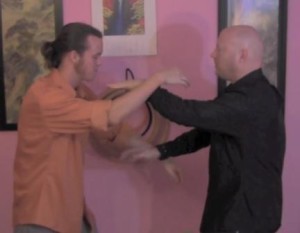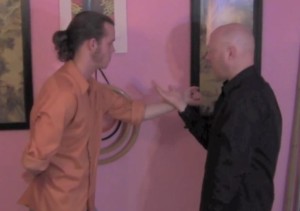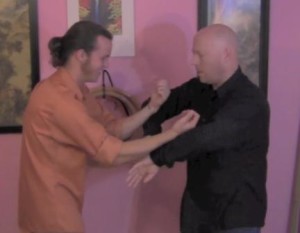After watching one of Sifu Tyler Rea’s videos about Lee Bing Choi Linage Chi Sau, I found
myself asking a lot of questions. If you are unfamiliar with the style, this type of Chi Sau is nothing like “traditional Ip Man” Chi Sau. If anything, it looks more like Tai Chi Push hands with Wing Chun shapes.
Our response?
We contacted him, asked a bunch of questions, and decided to share his answers with you!
How were you introduced to Lee Bing Choi style/linage of Wing Chun?
 Sifu Rea: In 1987 I was struggling to learn Wing Chun from an instructor who’sknowledge was less than complete or well applied. While attempting to find another Wing Chun teacher, my Silat Instructor, who worked as a health inspector, suggested I meet a friend of his who knew some Wing Chun. I was then introduced to his friend and co-worker Edmund Kwai. After roughly a year of study I was then introduced to his Wing Chun teacher and Brother-in-law Lee Bing Choi.
Sifu Rea: In 1987 I was struggling to learn Wing Chun from an instructor who’sknowledge was less than complete or well applied. While attempting to find another Wing Chun teacher, my Silat Instructor, who worked as a health inspector, suggested I meet a friend of his who knew some Wing Chun. I was then introduced to his friend and co-worker Edmund Kwai. After roughly a year of study I was then introduced to his Wing Chun teacher and Brother-in-law Lee Bing Choi.
Is the style from Hong Kong? Mainland China?
Sifu Rea: I was told that the “method” was originally taught as a Mainland Wing Chun branch, however Sifu’s Kwai and Choi lived most of their lives in Taiwan (prior to the US) while also traveling often to Hong Kong. After being diagnosed with Thyroid cancer, Sifu Kwai returned to Taiwan to spend the remainder of his time with his remaining family.
Do you feel the emphasis of the style if different than “mainstream Wing Chun” (i.e Ip Man Wing Chun)?
Sifu Rea: Yes. There are some definite differences in the initial structures and application tactics presented that differentiate the branches. I had in the past struggled with the initial differences that are apparent between what is called, mainstream/mainland/Ip Man Wing Chun.
Initially the progression of training for a beginner at first glance seems different however at their respective cores each arrives at and expresses Wing Chun DNA from different slightly directions. It was conveyed to me that this was due to times of transmission prior to that of a codified and established wooden dummy regimen. There was a time when I was concerned that no one seemed to be sharing this method and considered keeping it as a curiosity of Wing Chuns past.
It’s been a unique experience seeing the delineations between the various methods of Wing Chun. Having tasted a handful of Wing Chun branches and worked hard to refine, apply and appreciate them I have come to appreciate my Jook Wan Wing Chun more and more.
Would you say that the goal of this style isn’t to drive down the middle of the center line, similar to most Ip Man related styles? Rather deflect or redirect the force to the outer edge of your gate, followed by an attack to their center?
 Sifu Rea: Yes, I would agree with that keen observation and the best way I could offer an answer in a tactical comparison. Wing Chun most usually is a method designed to hold and maintain the tactical occupation of the Centerline plane. By contrast systems like those of the ethnic Hakka which include Southern Mantis, Bak Mei, Yau Gong Moon, and Dragon Shadow fist very often offer the attacker the Centerline plane. This tactical distinction can be the result of systems of the past simplifying the spacial gate theory of their system to two primary right & left gates or doors.
Sifu Rea: Yes, I would agree with that keen observation and the best way I could offer an answer in a tactical comparison. Wing Chun most usually is a method designed to hold and maintain the tactical occupation of the Centerline plane. By contrast systems like those of the ethnic Hakka which include Southern Mantis, Bak Mei, Yau Gong Moon, and Dragon Shadow fist very often offer the attacker the Centerline plane. This tactical distinction can be the result of systems of the past simplifying the spacial gate theory of their system to two primary right & left gates or doors.
Wing Chun closes the two doors “the Bridge arms and the space they guard” while some other systems open the two doors inviting the guest to attack. One primary reason the Jook Wan method opts to displace/deflect the forward attack pressure is to allow the practitioners elbows to slip past the initial bridge arm contact to strike or impale the opponent.
Is the footwork any different? Do you shift? I was watching some Chi Sau drills in Wing Chun University (WCU) and could not see the footwork. I couldn’t help but wonder if you kept turning your body to the side, or were you shifting to the side.
Sifu Rea: The footwork of the Jook wan method grows solely from what is know by most Ip Man Wing Chun practitioners as Cao Bo (Plucking step) or Heun Bo (circling step) depending on your terminology. A beginner is to place the Jook Wan ring on the ground and from a shoulder width horse stance, to circle the ring with alternating right and left leg.
When the level of practice is complete the student then visualizes the circle of the ring now within the space of a square with it’s sides slightly wider than the students shoulders. The student then holds the ring in a variation of double Lan sao called Bai wan.
While holding the ring in this position the student lines up their nose with the intersection of their wrists in the ring grip and slowly turns to the right corner of the imaginary square then to the left. This is performed alternating back and forth for several minute while supervised, while keeping the feet rooted to the ground with no applied pivot in the foot or bubbling well region of the foot.
Would It be unfair to say “Bong Sau” is used differently in this linage? One of the Chi Sau drills you taught in WCU uses a “double bong Sau” type sequence. Where as in styles that relate closer to Ip Man linage, the Bong Sau is often supported by a Wu Sau hand behind it.
Sifu Rea: That would be an accurate observation, often Bong sao structure is used to strike with in several ways. The first is in a Dai bong fashion punching much like that of the Oy got kuen punch found in some Biu jee forms but in a downward diagonal fashion.
Second is with the elbow from forward pressure like Wong jarng/Pai jarng or from the opposite pressure arc in Hao jarng. Thirdly in a snapping backhanded arc intersecting the inguinal crease and groin.
the Oy got kuen punch found in some Biu jee forms but in a downward diagonal fashion.
Second is with the elbow from forward pressure like Wong jarng/Pai jarng or from the opposite pressure arc in Hao jarng. Thirdly in a snapping backhanded arc intersecting the inguinal crease and groin.
Would it be wrong to say this style of Wing Chun is almost “Tai Chi’ish?” In the video from WCU, many of the drills reminded me of Tai Chi push hands drills.
Sifu Rea: You have a keen eye, sticking hands progression can be practiced within a wide spectrum of pressure to cultivate an equally wide range of skills. Because the instruction presented is beginner level I wanted to make certain to convey a patient level of reciprocal pressure with an emphasis on sticking and contact pivot.
Aside from rhythm and structure I wanted individuals to emulate a calm flow of pressure to heighten the players ability to feel and expand their bridge arm sphere forward. Far to often individuals both beginner and seasoned abruptly violate the structural and tactical protocols of a two person striking formula merely to exchange glancing cheep shots to the detriment of both. This control and smooth programming is essential to facilitate the advanced Anti-social sticking progressions which focus on the use of elbows and spade hands to soft tissue targets.
Towards the end of your Chi Sao video you were teaching in WCU, you taught “Ip Man Lop Sau” drills. Would you consider this to be part of the Lee Bing Choi curriculum?
Siu Rea: Both Sifu Kwai and Choi put a higher emphasis on the combat effectiveness and application realism of Lop Sao and similarly structured sets within the Jook Wan training transmitted to me. Over the years I have come to greatly appreciate the various levels of martial knowledge transmitted through Lop sao drills. As a result I wanted to make sure to include those lop sao sets and use them as a transition to the Elbow attacking curriculum.
In many of your DVDs and products you teach how to use the “Wing Chun Ring.” In short, how does it benefit your Wing Chun training?
Sifu Rea: Aside from being a compact and mobile training devise the Jook Wan ring helps me to not only cultivate and refine the most fundamental gross motor movements of Wing Chun but also dove tail with my White Eyebrow and Southern Mantis. Personally the ring allows me to have my cake, ice cream & dumplings and eat them all to.
Regarding the ring, would it be equally beneficial for more “mainstream”/Ip Man styles of Wing Chun? If so, why?
Sifu Rea: I would humbly assert yes, with the stipulation that they would not have to nor would they need to deviated from the movements of the system normally found in their respective Dummy forms.
Thank you Sifu Tyler Rea for taking the time to answer my questions.
Sifu Rea: Thank you for the opportunity to have this dialogue on the Martial arts, Ging Lai & best regards to you Scott, please edit my content as you wish.
If you would like to read more Wing Chun Interviews like this one, feel free to have a look at the interviews site: WingChunGeeks.com
If you would like to see Sifu Tyler Rea’s products, you can check them in Wing Chun University.

HI.i would like to learn your chi sau please.if it,s possible .send me from your lessons .thanks again
Off topic but I saw this and thought of you guys:
http://voices.yahoo.com/correcting-misconceptions-wing-chun-12167380.html